Silay | |
|---|---|
| City of Silay | |
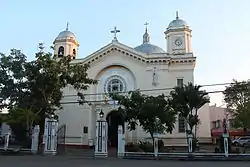 | |
 Flag  Seal | |
| Nickname(s): "The Paris of Negros" "The Visayan Marseille" | |
| Anthem: Silaynon Song | |
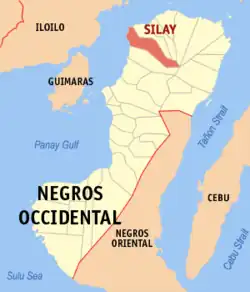 Map of Negros Occidental with Silay highlighted | |
OpenStreetMap | |
.svg.png.webp) Silay Location within the Philippines | |
| Coordinates: 10°48′N 122°58′E / 10.8°N 122.97°E | |
| Country | Philippines |
| Region | Western Visayas |
| Province | Negros Occidental |
| District | 3rd district |
| Founded | 1565 |
| Cityhood | June 12, 1957 |
| Barangays | 16 (see Barangays) |
| Government | |
| • Type | Sangguniang Panlungsod |
| • Mayor | Joedith C. Gallego |
| • Vice Mayor | Thomas Maynard J. Ledesma |
| • Representative | Jose Francisco B. Benitez |
| • City Council | Members |
| • Electorate | 89,483 voters (2022) |
| Area | |
| • Total | 214.80 km2 (82.93 sq mi) |
| Elevation | 57 m (187 ft) |
| Highest elevation | 1,398 m (4,587 ft) |
| Lowest elevation | 0 m (0 ft) |
| Population (2020 census)[3] | |
| • Total | 130,478 |
| • Density | 610/km2 (1,600/sq mi) |
| • Households | 32,693 |
| Demonym | Silaynon |
| Economy | |
| • Income class | 3rd city income class |
| • Poverty incidence | 17.60 |
| • Revenue | ₱ 893.6 million (2020) |
| • Assets | ₱ 1,367 million (2020) |
| • Expenditure | ₱ 934.2 million (2020) |
| • Liabilities | ₱ 587 million (2020) |
| Service provider | |
| • Electricity | Central Negros Electric Cooperative (CENECO) |
| Time zone | UTC+8 (PST) |
| ZIP code | 6116 |
| PSGC | |
| IDD : area code | +63 (0)34 |
| Native languages | Hiligaynon Tagalog |
| Website | www |
Silay, officially the City of Silay (Hiligaynon: Dakbanwa/Syudad sang Silay; Cebuano: Dakbayan sa Silay; Filipino: Lungsod ng Silay), is a 3rd class component city in the province of Negros Occidental, Philippines. According to the 2020 census, it has a population of 130,478 people.[3]
It is part of the metropolitan area called Metro Bacolod, which includes the cities of Bacolod (the metropolitan center) and Talisay.[5] It has a sizable commercial and fishing port and is the site of the new Bacolod–Silay International Airport, which replaced the old Bacolod City Domestic Airport.
Silay is often referred to as the "Paris of Negros"[6] due to its artists, cultural shows and large collection of perfectly preserved heritage houses. More than thirty of these houses have been declared by the National Historical Commission of the Philippines as part of the Silay National Historical Landmark.[7][8] In 2015, the city celebrated its 58th charter anniversary.[9]
Etymology
The appellation Silay is derived from the name of a native tree which grew abundantly in the area. The kansilay is the city's official tree.
The Legend of Princess Kansilay
A local legend tells of how Silay City got its name. It is said that in the days of the datus and rajahs, there once lived a princess named Kansilay. An attack on the settlement by pirates was thwarted when the princess bravely led the people in the village's defense. The fight was furious and the princess fought like a seasoned warrior. Murals that used to grace some of the city's public buildings depict her as a fierce fighter wielding a huge talibong, a short native single-edged sword. The pirates were routed, but at the cost of the princess' life. Her paramour arrived in time to see her die. In grief, the people lovingly buried her. To their surprise, a tree grew right over her grave, the first Kansilay tree, a final gift from the brave princess.
History
Spanish colonization
Silay was first settled in 1565, under the name "Carobcob", which means "to scratch" in Kinaray-a; residents of the settlement relied upon harvesting tuway clams, which involved "scratching" (or raking) the sands for the mollusks at low tide, as a means of livelihood. In early writings, the settlement was also referred to as "Calubcub", "Caracol" and "Caraco".[10] The last two variations mean "snail" or a "spiral" in Spanish. Carobcob was built near the mouth of a creek; nothing is left of the village today. Carobcob was granted as an encomienda to Cristobal Nuñez Paroja, one of the seventeen soldiers of Miguel López de Legazpi on January 25, 1571.
In the second half of the century, Moro slave raiders escalated their incursions on the large island, forcing the Corregidor of Negros to adopt the policy of flight rather than resistance. People left their homes sometime in 1760 and settled in a new location between two small rivers, Matagoy and Panaogao. A paloisades or estacada (Spanish for "palisade" or "stockade") was constructed to protect the populace from Moro raiders. The place is now known as Sitio Estaca, its name derived from the Spanish word estacada.
In 1760, Silay was recognized as a town being referred to in a letter from Governor Juan Jose de Mijares (1772–1775) mentioning Silay as a leading town in the north. In 1776, the bishop of Cebu considered Silay as the center of the parish. In 1760, it became a pueblo or town. By 1896, it had become a leading sugar-producing area because of the Horno Economico (sugar mill) built in 1846 by a Frenchman who became a permanent resident of Silay, Yves Leopold Germain Gaston.
Negros Revolution

With the outbreak of the Revolution of 1896 came a division between the sugarcane planters of Silay and the clergy. Some planters and clergy supported the rebels while others were against the revolution. On November 5, 1898, at about 2:00 in the afternoon, residents of Silay gathered in the street corner now known as Cinco de Noviembre Street and from there they proceeded to the Spanish garrison near the Catholic Church. The encounter was bloodless. The Spanish civil guard commander, Lt. Maximiano Correa, refused to surrender. After negotiations with the revolutionaries mediated by Juan Viaplana, a local Spaniard, the Spanish garrison did surrender. A Philippine flag was raised for the first time at the Silay plaza later that afternoon. Aniceto Lacson became president after the signing of the terms of surrender. Timoteo Unson and the group of Silay residents then marched south to join forces with some residents of Talisay for an attack on Bacolod, the capital.
World War II
On the slopes of Mt. Silay lies Patag, the site of Imperial Japan's last stand in Negros during World War II. In 1945, U.S. military forces landed in the island. The occupying forces of the Nagano Detachment of the Imperial Japanese Army retreated to Silay and proceeded up Mt. Silay to Patag. There, they established a defensive position. Military forces of the Philippine Commonwealth and soldiers of the U.S. 40th Infantry Division proceeded up the slopes of Mt. Silay with help from Filipino soldiers of the 7th, 72nd and 75th Infantry Division of the Philippine Commonwealth Army and Negrense guerrilla fighters and defeated the Japanese defenders. Today, the site is marked by a monument dedicated to the efforts which led to the liberation of the island of Negros.
Post-World War II
Cityhood
On June 12, 1957, Silay was converted into a city, by virtue of Republic Act 1621.
Culture

Silay City had been known in the past as the "Paris of Negros" and the "cultural and intellectual hub of Negros" due to the residents' love for knowledge and works of art, and its collection of heritage mansions built during the height of the Philippine sugar industry's success, of which Negros was the very center. Most notable among these houses is Balay Negrense, the mansion of the son of the first Negrense sugar baron, Yves Leopold Germain Gaston and the Hofileña Ancestral House built by Manuel Severino Hofileña for his wife, former Miss Silay Gilda Ledesma Hojilla.
Silay became a chartered city on June 12, 1957, by virtue of Republic Act 1621.
On June 7, 2003, Silay City became the first local government unit in the Republic of the Philippines to hold a referendum through a People's Initiative approving the 2003 annual executive budget.
Today, Silay City is listed by the Department of Tourism as one of its 25 tourist destinations in the Philippines. It is considered the seat of arts, culture and ecotourism in the Negros Island Region.
Hugyaw Kansilay Festival
Every 12th day of June, the city celebrates their annual festival called Hugyaw Kansilay Festival. The theme is derived from the story of Kansilay, which is also the origin of the city's name. The festival reflects the growth of Silay; from a lowly pueblo to a city that can hold its own among the country's best. The city's festival dance depicts the setting, characters, plot, sub-plots, conflict, climax and the story of the Legend of Kansilay.[11]
Geography
Silay City is 14 kilometres (8.7 mi) from Bacolod.
Barangays
Silay is politically subdivided into 16 barangays. Each barangay consists of puroks and some have sitios.
- Barangay I (Poblacion) (Urban Division)
- Barangay II (Poblacion) (Urban Division)
- Barangay III (cinco de Noviembre) (Poblacion) (Urban Division)
- Barangay IV (Poblacion) (Urban Division)
- Barangay V (Poblacion) (Urban Division)
- Barangay VI (Poblacion) (Hawaiian) (Rural Division)
- Eustaquio Lopez (Rural Division)
- Guimbala-on (Rural Division)
- Guinhalaran (Urban Division)
- Kapitan Ramon (Rural Division)
- Lantad (Rural Division)
- Mambulac (Urban Division)
- Rizal (Urban Division)
- Bagtic (Rural Division)
- Patag (Rural Division)
- Balaring (Rural Division)
Climate
| Climate data for Silay | |||||||||||||
|---|---|---|---|---|---|---|---|---|---|---|---|---|---|
| Month | Jan | Feb | Mar | Apr | May | Jun | Jul | Aug | Sep | Oct | Nov | Dec | Year |
| Mean daily maximum °C (°F) | 28 (82) |
29 (84) |
30 (86) |
32 (90) |
32 (90) |
31 (88) |
30 (86) |
29 (84) |
29 (84) |
29 (84) |
29 (84) |
28 (82) |
30 (85) |
| Mean daily minimum °C (°F) | 23 (73) |
23 (73) |
23 (73) |
24 (75) |
25 (77) |
25 (77) |
25 (77) |
24 (75) |
24 (75) |
24 (75) |
24 (75) |
23 (73) |
24 (75) |
| Average precipitation mm (inches) | 57 (2.2) |
37 (1.5) |
41 (1.6) |
42 (1.7) |
98 (3.9) |
155 (6.1) |
187 (7.4) |
162 (6.4) |
179 (7.0) |
188 (7.4) |
114 (4.5) |
78 (3.1) |
1,338 (52.8) |
| Average rainy days | 12.0 | 7.7 | 9.2 | 10.2 | 19.5 | 24.6 | 26.9 | 25.1 | 25.5 | 25.2 | 18.0 | 13.0 | 216.9 |
| Source: Meteoblue[12] | |||||||||||||
Demographics

| Year | Pop. | ±% p.a. |
|---|---|---|
| 1903 | 25,214 | — |
| 1918 | 23,328 | −0.52% |
| 1939 | 39,483 | +2.54% |
| 1948 | 35,570 | −1.15% |
| 1960 | 60,324 | +4.50% |
| 1970 | 69,200 | +1.38% |
| 1975 | 104,887 | +8.70% |
| 1980 | 111,131 | +1.16% |
| 1990 | 101,031 | −0.95% |
| 1995 | 122,748 | +3.72% |
| 2000 | 107,722 | −2.76% |
| 2007 | 120,365 | +1.54% |
| 2010 | 120,999 | +0.19% |
| 2015 | 126,930 | +0.92% |
| 2020 | 130,478 | +0.54% |
| Source: Philippine Statistics Authority[13][14][15][16] | ||
Economy
.jpg.webp)
Transportation
Airports
.jpg.webp)
The Bacolod–Silay International Airport, serves the whole Metro Bacolod area and surrounding places. The P4.37-billion airport is capable of handling all-weather and night-landing operations. Its 2,000-meter (6,600 ft.) long and 45-meter (148 ft.) wide primary runway, and 678-meter by 23-meter taxiways can accommodate Airbus A320 family-size aircraft, and the Boeing 737, while the apron can hold five aircraft at any one time. The runway runs in a direction of 03°/21°. Provisions for a 500-meter (1,600 ft) expansion of the present runway in order to accommodate even larger airplanes like the Airbus A330, Airbus A340 and Boeing 747 are now in place. The airport is expected to be the primary entrance by air to Negros Island Region.
Silay is 50 minutes by air from Manila, 30 minutes by air from Cebu, 1 hour by air from Cagayan de Oro and 37.2 minutes by air from General Santos. Commercial airlines operating in the Bacolod–Silay International Airport are Philippine Airlines, Cebu Pacific Air, PAL Express, and Philippines AirAsia.
Education
In Silay City, there are 31 schools that are officially listed by the city's Department of Education.
Public schools
Elementary
- Silay South Elementary School
- Silay North Elementary School
- Governor Emilio Gaston Memorial Elementary School
- Barangay Mambulac Elementary School
- Guinhalaran Integrated School
- Balaring Elementary School
- Don Estaquio Hofileña Memorial School
- Villa Miranda Elementary School
- Estaquio Lopez Elementary School
- Don Homero Hilado Tanpinco Elementary School
- Patag Elementary School
- Silay SPED Center (Elementary)
- Salvacion Elementary School
- Emiliano Lizares Elementary School
- Hinicayan Elementary School
- Hawaiian-Philippine Company Elementary School
- Santo Rosario Elementary School
- La Purisima Concepcion Elementary School
High schools
- Doña Montserrat Lopez Memorial High School
- Barangay E Lopez National High School
- Barangay Guimbalaon National High School
- Don Felix T. Lacson Memorial National High School
- Doña Montserrat Lopez Memorial High School HPCO Extension
- Doña Montserrat Lopez Memorial High School Patag Extension
- Doña Montserrat Lopez Memorial High School Santo Rosario Extension
- Don Albino and Doña Dolores Jison Integrated School
- Lantawan Integrated School
- Don Serafin L. Golez Memorial Integrated School
- Napilas Integrated School
- Sibato Integrated School
- Violeta Integrated School
- Silay SPED Center
- Guinhalaran Integrated School
Private schools
- St. Theresita's Academy
- Silay Institute
- Cinco De Noviembre Learning Center
- Faith Christian Academy-Silay Incorporated
- St. Francis of Assisi of Silay Foundation Inc.
- San Diego Study Center
- Silay Hope Baptist Academy
- L'ecole Silay
Gallery
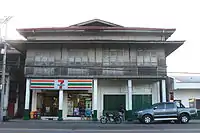 The renowned convenience store 7/11 is now open in the city.
The renowned convenience store 7/11 is now open in the city. The Hofileña Ancestral House is the first museum in the city to open in public.
The Hofileña Ancestral House is the first museum in the city to open in public. Dr. Jose Corteza Locsin Ancestral House is one of the ancestral houses in the city. It was the domicile of the late Sen. Jose C. Locsin.
Dr. Jose Corteza Locsin Ancestral House is one of the ancestral houses in the city. It was the domicile of the late Sen. Jose C. Locsin. The Bernandino Jalandoni Ancestral House or also known as the "pink house, is one of the museums in the city.
The Bernandino Jalandoni Ancestral House or also known as the "pink house, is one of the museums in the city.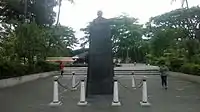 A Dr. Jose Rizal statue is located at the Silay City Public Plaza.
A Dr. Jose Rizal statue is located at the Silay City Public Plaza. The smallest doll in the world can be found in Hofileña Ancestral House.
The smallest doll in the world can be found in Hofileña Ancestral House. The Balay Negrense is the most visited museum in the city.
The Balay Negrense is the most visited museum in the city.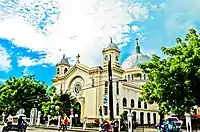 The San Diego Pro-Cathedral is the only church in the province that has a dome.
The San Diego Pro-Cathedral is the only church in the province that has a dome.
Sister cities
Silay City has been twinned with the following cities:
Local
International
 Marseille of Provence-Alpes-Côte d'Azur, France
Marseille of Provence-Alpes-Côte d'Azur, France Amagi of Kagoshima Prefecture, Japan
Amagi of Kagoshima Prefecture, Japan
Notable residents
See also
References
- ↑ City of Silay | (DILG)
- ↑ "2015 Census of Population, Report No. 3 – Population, Land Area, and Population Density" (PDF). Philippine Statistics Authority. Quezon City, Philippines. August 2016. ISSN 0117-1453. Archived (PDF) from the original on May 25, 2021. Retrieved July 16, 2021.
- 1 2 Census of Population (2020). "Region VI (Western Visayas)". Total Population by Province, City, Municipality and Barangay. Philippine Statistics Authority. Retrieved July 8, 2021.
- ↑ "PSA Releases the 2018 Municipal and City Level Poverty Estimates". Philippine Statistics Authority. December 15, 2021. Retrieved January 22, 2022.
- ↑ "Building Globally Competitive Metro Areas in the Philippines" (PDF). Archived from the original (PDF) on July 5, 2010. Retrieved June 16, 2010.
- ↑ "Silay City – Negros Occidental Provincial Government". Archived from the original on May 7, 2016. Retrieved January 3, 2012.
- ↑ National Historical Commission of the Philippines (July 1990). "Declaring a Portion of Silay City, Negros Occidental, A National Historical Landmark" (PDF). Archived from the original (PDF) on June 22, 2015. Retrieved June 22, 2015.
- ↑ National Historical Commission of the Philippines (October 30, 1990). "Amending Resolution No. 2, s. 1990, Dated July 1990, Declaring a Portion of Silay City, Negros Occidental, A National Historical Landmark" (PDF). Archived from the original (PDF) on June 22, 2015. Retrieved June 22, 2015.
- ↑ Pacete, Severino (June 9, 2015). "Silaynons who made Silay". SunStar. Retrieved June 22, 2015.
- ↑ Sa-onoy, Modesto (2006). Parroquia de San Diego. Today Printers and Publishers. p. 1.
- ↑ Ver. F. Pacete (June 4, 2016). "Kansilay Festival Dance". Sunstar.
- ↑ "Silay: Average Temperatures and Rainfall". Meteoblue. Retrieved May 7, 2020.
- ↑ Census of Population (2015). "Region VI (Western Visayas)". Total Population by Province, City, Municipality and Barangay. Philippine Statistics Authority. Retrieved June 20, 2016.
- ↑ Census of Population and Housing (2010). "Region VI (Western Visayas)" (PDF). Total Population by Province, City, Municipality and Barangay. National Statistics Office. Retrieved June 29, 2016.
- ↑ Censuses of Population (1903–2007). "Region VI (Western Visayas)". Table 1. Population Enumerated in Various Censuses by Province/Highly Urbanized City: 1903 to 2007. National Statistics Office.
{{cite encyclopedia}}: CS1 maint: numeric names: authors list (link) - ↑ "Province of". Municipality Population Data. Local Water Utilities Administration Research Division. Retrieved December 17, 2016.
- ↑ "Poverty incidence (PI):". Philippine Statistics Authority. Retrieved December 28, 2020.
- ↑ "Estimation of Local Poverty in the Philippines" (PDF). Philippine Statistics Authority. November 29, 2005.
- ↑ "2003 City and Municipal Level Poverty Estimates" (PDF). Philippine Statistics Authority. March 23, 2009.
- ↑ "City and Municipal Level Poverty Estimates; 2006 and 2009" (PDF). Philippine Statistics Authority. August 3, 2012.
- ↑ "2012 Municipal and City Level Poverty Estimates" (PDF). Philippine Statistics Authority. May 31, 2016.
- ↑ "Municipal and City Level Small Area Poverty Estimates; 2009, 2012 and 2015". Philippine Statistics Authority. July 10, 2019.
- ↑ "PSA Releases the 2018 Municipal and City Level Poverty Estimates". Philippine Statistics Authority. December 15, 2021. Retrieved January 22, 2022.
- ↑ "Silay City celebrates Tourism Month". Philippine Information Services. September 2, 2008. Retrieved September 4, 2008.
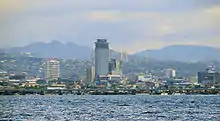
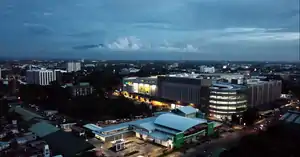

.jpg.webp)